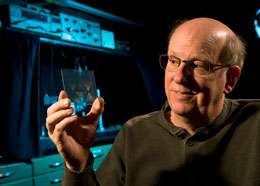In Brief: 'Multiple exciton collection' could result in more efficient solar cells

(PhysOrg.com) -- A University of Wyoming professor's findings, published today in the journal Science may open the door to new designs for inexpensive and higher efficiency solar cells.
Bruce Parkinson, distinguished professor in the Department of Chemistry and the School of Energy Resources at UW, is one of three authors of the Sept. 30 article, "Multiple Exciton Collection in a Sensitized Photovoltaic System." Other authors are Justin B. Sambur, a graduate student from Colorado State University who works with Parkinson at UW, and Thomas Novet with Voxtel Incorporated in Beaverton, Ore.
Parkinson explains that photovoltaic solar cells, like the ones that can be seen on an increasing number of roofs, convert only a small fraction of the energy in sunlight directly into electricity. Scientists have predicted that it is possible to increase their efficiency by converting the high-energy part of sunlight into additional electrical current.
"Despite results from other experiments showing that this was possible, no one had demonstrated the generation of this additional current in a photovoltaic device," Parkinson says.
The research at the University of Wyoming used a model photovoltaic system, containing small semiconducting particles called quantum dots, to demonstrate the collection of twice the number of electrons from high-energy photons.
He says the findings offer a major step toward developing more efficient solar cells.
More information: Justin B. Sambur et al., Multiple Exciton Collection in a Sensitized Photovoltaic System, Science 1 October 2010: Vol. 330. no. 6000, pp. 63 - 66. DOI: 10.1126/science.1191462
Provided by University of Wyoming



















